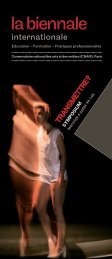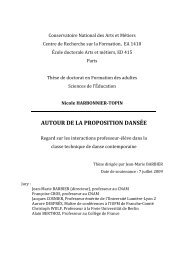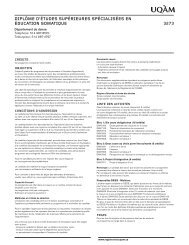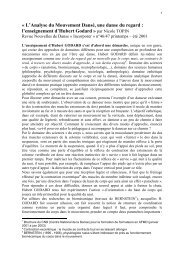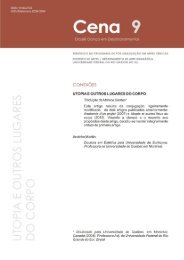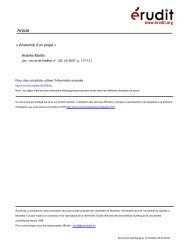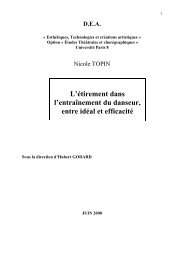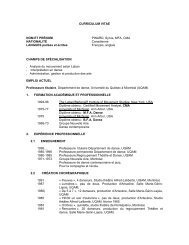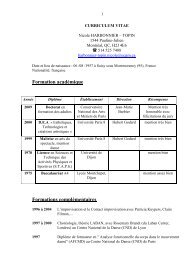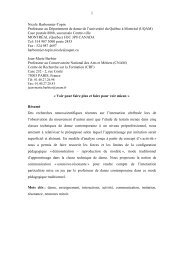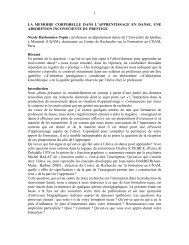Day 2 - Département de danse - UQAM
Day 2 - Département de danse - UQAM
Day 2 - Département de danse - UQAM
Create successful ePaper yourself
Turn your PDF publications into a flip-book with our unique Google optimized e-Paper software.
The objective of this Seminar, therefore, is not to establish singular <strong>de</strong>finitions of Practice-Based Research (or any of its<br />
variations), nor to impose specific theoretical, methodological, or practical criteria. Rather, it is meant as a forum that will<br />
celebrate diversity in PBR motivation, <strong>de</strong>sign, execution, and documentation. However, what participation in the seminar will<br />
emphasize is pronounced rigour, reflection, and <strong>de</strong>tail in the articulation of the PBR processes examined, across the following<br />
aspects: focus, objectives, context, participants, methodology, process <strong>de</strong>sign, documentation, and results (as opposed to<br />
“products”). A field as invested in multiplicity and variation as PBR/PaR is equally tasked with clarity and sophistication in its<br />
self-presentation; it is my hope that this Seminar will contribute, in some small way, to this cause.<br />
d) To Other Shores … with Love! A Canadian Abroad (to 3:45pm) Fine Arts 103<br />
Curated Panel Mo<strong>de</strong>rator: Yana Meerzon (University of Ottawa)<br />
“Canadians in Montenegro: Odysseus, Penelope, Citations and Iterations.” Kathleen Irwin<br />
(University of Regina) and Dragana Varagic (Aca<strong>de</strong>my of Arts, Alpha University Belgra<strong>de</strong>)<br />
This paper looks at a Montenegrin translation of Margaret Atwood’s The Penelopiad, by Toronto-based April Productions for<br />
the Purgatorio Festival / 2012 in Montenegro, directed by Dragana Varagic, and scenography by Kathleen Irwin. Beyond the<br />
unique material location of this production (an outdoor stage abutting the seventeenth-century tower of the Tivat Cultural<br />
Centre, overlooking the historically contested Bay of Kotor on the Adriatic coast) and the current socio /political contingencies<br />
of this part of the world, there are interesting links and interconnections bound up in this production. These reference the<br />
multiple migrations and colonizations that interleave Atwood’s feminist retelling of the legend of the Odyssey—the hero’s<br />
leave-taking for the Peloponnesian Wars and his eventual homecoming. This presentation cites the narratives that bind and<br />
divi<strong>de</strong> those who have lived through war and intense political turmoil, and those who haven’t; those who leave and those who<br />
stay.<br />
The Penelopiad is Atwood’s response to Homer’s epic poem retold from Penelope’s perspective. Destined to Ha<strong>de</strong>s, she<br />
remains haunted by her twelve maids who are mur<strong>de</strong>red by her husband upon his return after 20 years in battle. Varagic takes<br />
her inspiration from Brecht and transports this contemporary Canadian play back to the story’s roots. Surroun<strong>de</strong>d by a culture<br />
and an audience firmly groun<strong>de</strong>d in epic tradition, she and Irwin discover the resonances and echoes that form the multiple<br />
layers of the production. At the same time, their interpretation introduces a mo<strong>de</strong>rn and Canadian perspective on the<br />
importance of women’s voices.<br />
The presentation will move between Varagic and Irwin as both recount aspects of the project and their own relations with<br />
this part of the world and with this particular production that uniquely connects Atwood’s play with its original mythical setting.<br />
“Arabic Facts in Palestine: The Clash of Diversity, Transnationalism, and Hybridity in Cultural<br />
Production.” Samer Al-Saber (University of Washington)<br />
After negotiations with several Palestinian theatres in Jerusalem and the West Bank, Bethlehem’s Al-Rowwad Theatre<br />
un<strong>de</strong>rtook the challenge of co-producing Arthur Milner’s Facts for a ten-city tour in the region. The successful production and<br />
warm reception to the play highlighted the potential for more Canadian playwrights, companies and artists to engage with<br />
Palestine through cultural and theatrical exchanges. It also highlighted a series of challenging political, cultural and<br />
philosophical differences, which emerged in rehearsal, talkbacks, and audience reception. A textual analysis of the play and a<br />
conceptual analysis of the production suggest that the transnational translation of the play occurred from Canada to Palestine<br />
and within Palestinian communities as audiences in different cities reacted in remarkably different ways. In Hebron, the<br />
audience respon<strong>de</strong>d to the engagement with settlers and the predominant presence of the Goldstein massacre in the end of<br />
the play. In Bethlehem, political issues of security coordination dominated the discussion. The mixed Israeli-Palestinian<br />
audience in Jaffa reacted in similar ways to the Canadian audience in Ottawa, focusing on the rift between religious and<br />
secular Israel. In several cities, the production experienced its own diverse transnational experience, reflecting the Canadian<br />
origins of the play, its hybridity in production, its international appeal, and its local significance. In this paper, I outline the<br />
mechanisms and challenges of the production through a methodical <strong>de</strong>scription, analysis, and critique of the process that led<br />
to opening night in Bethlehem’s Dar Al-Kalima, and closing night at Al-Rowwad. From the checkpoint to closing night, I recall a<br />
road map for such successful partnerships, while revealing the inevitable clashes of values that take place in transnational<br />
cultural productions.<br />
“Crafting Native Idioms: Contemporary Indigenous Playwrights in Canada and Globalization.”<br />
Marc Maufort (University of Brussels, Belgium)<br />
Contemporary Indigenous theatre in Canada offers an i<strong>de</strong>al vantage point from which to examine the ways in which Native<br />
playwrights have reinvented traditional Euro-American dramatic realism so as to assert the uniqueness of their culture in<br />
today’s “global village.” Through such a reinvented stage realism, they seek to avoid the homogenizing impact of globalization<br />
and offer a plurality of <strong>de</strong>finitions of what Native aesthetics can mean, thereby resisting the Western ten<strong>de</strong>ncy to ghettoize<br />
Native writing in rigid literary categories. The innovative ways in which Native playwrights forge these localized idioms remains<br />
a hitherto un<strong>de</strong>rstudied form of resistance against globalization. The three case studies of this paper examine these idiomatic<br />
aesthetic <strong>de</strong>vices in <strong>de</strong>tail, contrasting works by Marie Clements, Tomson Highway and Kevin Loring. Marie Clements blends<br />
dramatic art and photography in her recent The Edward Curtis Project: A Mo<strong>de</strong>rn Picture Story. In Ernestine Shuswap Gets<br />
Her Trout, Tomson Highway uses language in such as a way as to enco<strong>de</strong> the special bond between Native people and the<br />
land. In Where the Blood Mixes, Loring resorts to magical realism in or<strong>de</strong>r to enact the i<strong>de</strong>ntities of his Native community.<br />
34



